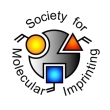Authors: Arabzadeh N, Khosravi A, Mohammadi A, Mahmoodi NM
Article Title: Enhanced photodegradation of hazardous tartrazine by composite of nanomolecularly imprinted polymer-nanophotocatalyst with high efficiency.
Publication date: 2015
Journal: Desalination and Water Treatment
Page numbers: 1-10.
DOI: 10.1080/19443994.2014.989414
Abstract: In this research, a nanocomposite of molecularly imprinted polymer (MIP)-nanophotocatalyst for enhanced photodegradation of tartrazine with high efficiency and nanocomposite of non-imprinted polymer (NIP)-nanophotocatalyst were synthesized by precipitation polymerization and it was carried out in an aqueous medium to employ a green method. Acrylamide as functional monomer, N,N'-methylene-bis-acrylamide as cross-linking agent, tartrazine as a template, and TiO2 as a nanophotocatalyst were used. The synthesized nanocomposites (MIP-TiO2 and NIP-TiO2) were characterized by using thermal gravimetric analysis, scanning electron microscopy, transmission electron microscopy, and Fourier transform infrared spectroscopy. The MIP nanocomposite as an effective sorbent was used to extract and photodegrade tartrazine from water media. The effects of pH, time, and concentration of tartrazine solution and kinetics of photodegradation of tartrazine were investigated. The best pH and the optimum time for tartrazine photodegradation in a 10 ml solution containing tartrazine (3 x 10-5 M) and nanocomposite (1 mg) were obtained to be 2 and 5 h, respectively. The results showed that the MIP nanocomposite has improved the photodegradation of tartrazine by 100% compared to NIP nanocomposite and pure nanophotocatalyst which yielded at 63 and 56%, respectively, under the same condition
Author keywords: Enhanced photodegradation, MIP nanocomposite, Tartrazine, NIP nanocomposite, Green synthesis, TiO2 nanophotocatalyst



Join the Society for Molecular Imprinting

New items RSS feed
Sign-up for e-mail updates:
Choose between receiving an occasional newsletter or more frequent e-mail alerts.
Click here to go to the sign-up page.
Is your name elemental or peptidic? Enter your name and find out by clicking either of the buttons below!
Other products you may like:
 MIPdatabase
MIPdatabase









